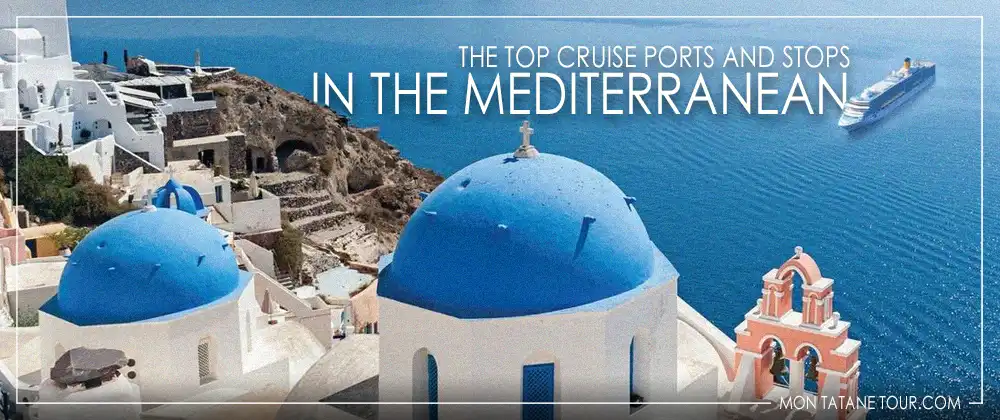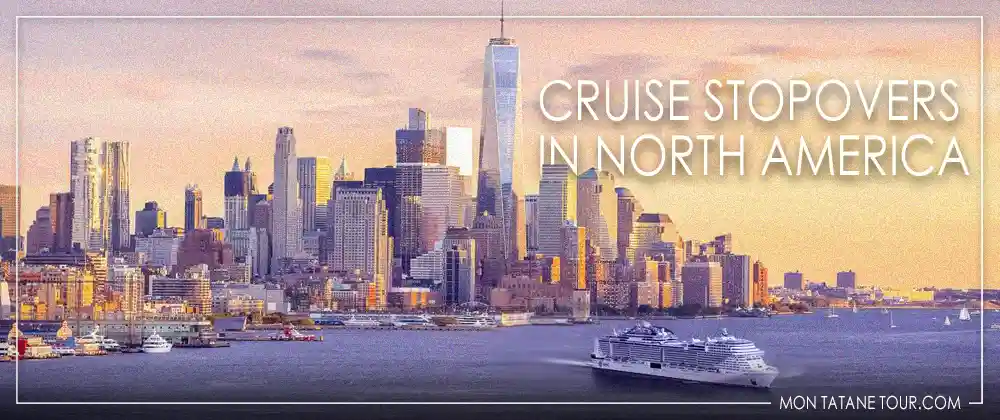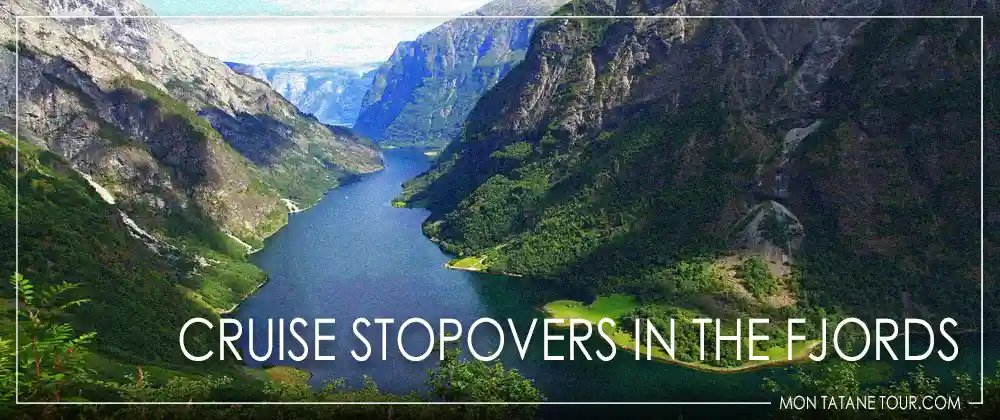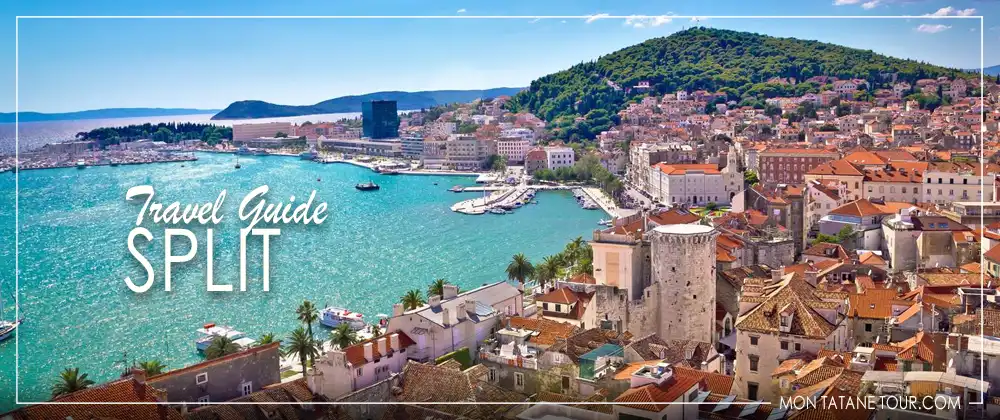Welcome aboard this comprehensive guide to “Split travel guide”.
I’m Sarah ( or Miss Tatane 😛), passionate about cruising and travel. I’m here to share my experiences and advice with you, so you can experience each destination to the full 😉.
Don’t forget to add us to your favorites if you’re thinking of cruising again! Our MTT site (yours) is constantly updated with new articles every week, as well as new destinations as we travel.😀
Split travel guide – Must-see places

Diocletian’s palace
Split travel guide – a Journey through time
Diocletian’s Palace, located in Split, Croatia, is a historic monument built by the Roman Emperor Diocletian in the late 3rd century AD. It was initially designed as an imperial residence and military fortress.

- World Heritage. Due to its historical importance and its exceptional state of conservation, the palace is listed as a UNESCO World Heritage Site. It constitutes one of the best preserved examples of Roman architecture.
Tour Highlights
- Ancient architecture. The palace is an impressive example of Roman architecture, with its massive walls, monumental gates and elaborate structures. It includes temples, residential buildings and public squares.
- Peristyle. This central courtyard, surrounded by columns, is one of the highlights of the palace. It is a popular meeting place, where visitors can admire the architecture and watch performances of klapa, a traditional Croatian song.
- Saint-Domnius Cathedral. Initially the mausoleum of Diocletian, this building was transformed into a cathedral in the 7th century. It is famous for its bell tower offering a panoramic view of the city.
- The underground. Explore the palace’s extensive basements, used during Roman times for storage and service needs. Today, they host local craft exhibitions and markets.

Useful information
- Access. Diocletian’s Palace is located in the historic center of Split, easily accessible on foot from most hotels and points of interest in the city. Split train station and bus station are also nearby, making arrivals by public transport easy.
- Schedules. The palace is open all year round, and most areas are free to enter.
Marjan hill Split
Split travel guide – Marjan park
Marjan Hill, located west of Split, Croatia, is a historic forest park enjoyed since the times of the Roman Empire. It has been developed over the centuries to provide a natural refuge for locals and visitors.
- Local importance. Known as the “lungs of Split” due to its extensive Mediterranean vegetation. It is a place of relaxation and leisure for the city’s residents, providing a refreshing contrast to the bustle of the historic center.

Tour Highlights
- Hiking trails. Marjan Hill offers many well-maintained hiking trails. Be careful though if you’re not athletic, it’s really physical if you take the stairs. If you wish you can visit Split and go up to Marjan by tuk-tuk
- Panoramic viewpoints. Several lookout points on the hill offer impressive panoramas of Split, the sea and the surrounding islands. The Telegrin viewpoint is particularly popular for its stunning sunsets.
- Hermitages and churches. The hill is home to several small churches and hermitages, such as the Church of Saint Nicholas and the Hermitage of Saint Jerome, dating from the Middle Ages. These sites offer a fascinating insight into the religious and cultural history of the region.
- Beaches and coves. At the foot of the hill you will find picturesque beaches and secluded coves ideal for swimming and relaxing.

Useful information
- Access. Marjan Hill is accessible on foot from the center of Split. You can also take a bus or tuk tuk. For the more sporty, renting a bike is a great option to explore the hill and its surroundings.
- Schedules. The park opens all year round and entry is free.

Why visit Marjan Hill?
- Outdoor activities. Whether you like hiking, cycling, swimming or just hanging out, Marjan offers a multitude of outdoor activities for all tastes and ages.
- Panoramic view. Marjan viewpoints offer some of the best views in Split.
- Cultural Heritage. In addition to its natural beauty, Marjan is rich in history and culture.
Split market
A burst of flavors, colors, and shopping
Split Market, also known as Pazar, is a vibrant and historic place.

The market represents the heart of daily life in Split. It offers an authentic immersion into local culture, where locals and visitors meet to buy fresh produce and exchange stories.
Tour Highlights
- Fresh products. The market is full of colorful stalls offering a variety of fresh produce. You will find seasonal fruits and vegetables, aromatic herbs, honey, local cheeses, and fresh meats.
- Local specialties. Don’t miss local specialties like olive oil, Dalmatian prosciutto, and freshly caught fish. These products reflect the gastronomic richness of the region.
- Crafts and souvenirs. In addition to food products, the market offers stalls selling local crafts. Discover unique souvenirs such as handmade clothing, jewelry, and pottery items.

Useful information
- Access. The Split market is 5 minutes from Diocletian’s Palace, in the city center. It is easily accessible on foot from most points of interest in the city (hotel, cruise port, etc.).
- Schedules . The market is open every day, generally from morning until afternoon. To enjoy the freshest produce and lively atmosphere, getting there early is recommended.
Architecture
Split travel guide – an invitation to explore

Forget boring history lessons. In Split, architecture is an invitation to discover, marvel, and explore. Every building, every cobblestone street, every square holds a unique story that will transport you through the ages. You won’t be able to resist getting lost in this labyrinth of beauty.
Imagine wandering through the hidden courtyards of Diocletian’s Palace, a site that saw the birth of this city centuries ago. You’ll soak in the grandeur of Roman columns, the intimate atmosphere of medieval churches, and the serenity of squares where local life comes to life.

But that’s not all. Split is also a canvas where modern architectural creations blend with historical elements. You’ll be dazzled by this harmonious fusion of past and present.

It’s an invitation to live history, feel culture, and explore Split’s hidden treasures. Get ready to be charmed, inspired, and most importantly, eager to stay and discover even more.
The Game of Thrones museum
Split travel guide
The Game of Thrones Museum in Split celebrates the impact of the hit TV series which was partially filmed in Croatia. Split and its surroundings served as the setting for several memorable scenes, paying homage to the universe of Westeros.

- Local atmosphere. The museum immerses visitors in the fantastical world of Game of Thrones, providing an immersive experience through interactive exhibits, authentic props and recreations of iconic scenes.
Tour Highlights
- Interactive exhibitions. The museum features interactive exhibits where fans can interact with items from the series. Touch screens and multimedia presentations enrich the experience by providing detailed information about scenes and filming locations.
- Authentic accessories. Admire an impressive collection of props, costumes and replica weapons used in the series. Each room tells a story, transporting visitors to the different regions of Westeros.
- Scene reconstructions. The sets and scene reconstructions allow visitors to relive key moments from the series. Stroll the streets of King’s Landing or take a seat on the Iron Throne for an unforgettable souvenir photo.
Useful information
- Access. The Game of Thrones Museum is located in the center of Split, near Diocletian’s Palace. It is easily accessible on foot from the main tourist sites of the city.
- Schedules. The museum is open every day of the week, generally from 10 a.m. to 6 p.m. To avoid crowds, it is recommended to visit early morning or late afternoon.
- Tickets. Entrance to the museum costs 14.50 euros. It is possible to purchase tickets here in advance to avoid queues and benefit from reduced prices.

Why visit the Game of Thrones Museum?
- Full immersion. Immerse yourself in the world of Game of Thrones and discover behind the scenes of the series. The museum offers an immersive experience that will delight fans and the curious.
- Decors and accessories. Explore faithful sets and discover authentic props used by the actors. Every detail is carefully presented to provide a realistic and captivating experience.
- Historic location. In addition to visiting the museum, take the opportunity to explore Split and its surroundings, which served as the backdrop for several scenes in the series. Combining the rich history of Split and the magic of Game of Thrones creates a unique experience.
- Entrance ticket reservation.
Krka waterfalls
Nature in all its splendor

Krka Falls, located in the Krka National Park in Croatia, has amazed with its natural beauty for centuries.
- Natural atmosphere. The Krka Waterfalls attract visitors with their turquoise waters and lush vegetation, providing an idyllic setting for relaxation and exploration.
Tour Highlights
- Skradinski Buk Waterfalls. The most famous waterfall, Skradinski Buk, impresses with its numerous waterfalls and natural pools. Swim in crystal clear waters and relax in the sun.
- Roški Slap waterfalls. Lesser known but equally magnificent, the Roški Slap waterfalls offer spectacular views and picturesque hiking trails. Explore the traditional water mills and enjoy the tranquility of the site.
- Krka Monastery. The 14th-century Orthodox Krka Monastery offers a peaceful and spiritual place surrounded by stunning natural scenery.
Useful information
- Access. Reach Krka National Park by car, bus or boat from Split , located around 90 km away. You can also opt for an organized excursion.
- Tickets. Buy your tickets online . The price is 27 euros.
Why visit Krka Falls?
- Natural beauty. Krka Falls, with its majestic waterfalls and breathtaking landscapes, will delight nature lovers and photographers.
- Outdoor activities. The park offers many activities such as hiking, swimming and picnicking. Hike the well-marked trails and admire the breathtaking panoramic views.
- Cultural wealth. The park is home to important historical and cultural sites, such as the Krka Monastery and traditional water mills.
- From Split – Mostar and visit to Kravice Waterfalls

The blue cave
Split travel guide

The Blue Cave, located on the island of Biševo in Croatia, fascinates with its natural beauty and captivating history. Discovered in 1884 by a local painter, this cave is today a major tourist attraction in the Adriatic.
- Enchanted atmosphere. The Blue Grotto attracts visitors with its bright blue waters and silvery reflections. Sunlight, filtered through an underwater opening, creates a magical, fairy-tale atmosphere inside the cave.
Tour Highlights
- Light show. The Blue Grotto offers a unique light show. In the middle of the day, when the sun is at its highest, the cave fills with blue and silver reflections that create an unforgettable visual experience.
- Navigation. Access the cave by boat. The ride to the Blue Grotto passes through crystal clear waters and offers panoramic views of the surrounding islands, adding a touch of adventure to your visit.
- Exploration. Once inside, admire the natural beauty of the cave. The rock formations and the play of light provide a perfect setting for photography and contemplation.
Useful information
- Access. Reach the Blue Grotto by boat from Split or other nearby islands. Several boat tours are available, offering frequent departures throughout the day.
- Schedules. The best time to visit the cave is between 11 a.m. and 2 p.m., when the sunlight is at its peak. Excursions usually start early in the morning and continue until the afternoon.
- Tickets. Buy your tickets for the boat trip from Split.
Why visit the blue cave?
- Dazzling beauty. The Blue Grotto, with its luminous waters and magical reflections, offers an incomparable visual experience. It is an ideal place for nature lovers and photographers.
- Adventure at sea. The boat trip to the cave adds a dimension of adventure to your visit. Sail through the turquoise waters of the Adriatic and enjoy the breathtaking landscapes of the Croatian islands.
- Unique experience. The Blue Grotto is a rare and exceptional natural site. The opportunity to see such a natural wonder is a memorable and unique experience.
Strong demand for reservations!
Split travel guide – the lively city center
Where history meets modern life

The Riva, also known as the Split waterfront, is an iconic place in the city. This historic boulevard runs along the coast and offers breathtaking views of the Adriatic Sea. The Riva is the beating heart of Split, a place where history and modernity meet.
- Lively atmosphere. La Riva attracts locals and tourists with its vibrant ambiance. The cafes, restaurants, and shops lining the promenade create a dynamic and friendly atmosphere.
Tour Highlights
- Panoramic walk. Stroll along the Riva to enjoy the panoramic view of Split Harbor and the Adriatic Sea. The promenade is ideal for a relaxing stroll, especially at sunset.
- Cafes and restaurants. Relax in one of the many cafes and restaurants that line the Riva. Taste local specialties while observing the bustling boulevard and the boats docked.
- Events and festivals. La Riva is often the venue for festivals, open-air concerts and various cultural events.

Useful information
- Access. La Riva is right in the city center of Split, easily accessible on foot from main attractions like Diocletian’s Palace, the cruise port.
- Schedules. The Riva is lively all day long, but the atmosphere becomes particularly pleasant in the late afternoon and evening. Cafes and restaurants stay open late, allowing you to enjoy Split’s nightlife.
- Activities. Besides walking, you can take guided tours, shop in local boutiques, or simply relax on a bench admiring the view.
Split travel guide – Saint Domnius Cathedral

St. Domnius Cathedral, also known as Sveti Duje, is located in the heart of Diocletian’s Palace in Split. Built in the 4th century, this cathedral is one of the oldest Christian structures still in use.
- Historical context. Originally a mausoleum for Emperor Diocletian, the structure was transformed into a cathedral in the 7th century. It is named after Saint Domnius, the patron saint of Split, martyred under Emperor Diocletian.
Tour Highlights
- Impressive architecture. The cathedral combines elements of Roman and medieval architecture. Its exterior, with its Roman columns and detailed carvings, bears witness to its imperial past.
- Panoramic bell tower. Climb the 57-meter cathedral bell tower for panoramic views of Split, Diocletian’s Palace and the Adriatic Sea. The climb is a bit steep, but the view is worth it.
- Historic interior. The interior of the cathedral is home to artistic treasures, including 13th-century wood carvings, a finely crafted marble altar, and medieval frescoes.
Useful information
- Access. Located in the center of Split, the cathedral is easily accessible on foot from any point in the Old Town. Split’s main attractions are within walking distance.
- Schedules. The cathedral is open from 8 a.m. to 8 p.m. (in winter it closes at 6 p.m.).
- Tickets. Entrance to the cathedral and the bell tower costs between 7 and 10 euros depending on what you want to visit.
Klis fortress
A Journey into the Medieval Past and Game of Thrones

Klis Fortress, located near Split in Croatia, is a majestic historic site with origins dating back to ancient times. Perched on a steep cliff, it offers a strategic view of the surrounding region and has played a crucial role in the city’s defense over the centuries.
- Resistance symbol. Klis Fortress is also known for its role in the resistance against Ottoman invaders in the 15th century, symbolizing the bravery and determination of the region’s inhabitants.
Tour Highlights
- Panoramic view. Climb up to the fortress to enjoy spectacular panoramic views of Split, neighboring islands and the Adriatic Sea. It’s the perfect place for memorable photos and to admire the scenery.
- Medieval architecture. Explore the fortress’ imposing walls and towers, which reflect medieval military architecture. Discover the historical remains and imagine the lives of the soldiers who once protected this place.
- Museum and exhibitions. Inside the fortress, visit the museum which traces the turbulent history of Klis through fascinating exhibits on art, military history and local culture.
Useful information
- Access. Klis Fortress is located about 12 km north of Split. You can get there by car or bus from Split. The journey takes approximately 30 minutes.
- Schedules. The fortress is open every day with hours which may vary depending on the season. It is recommended to check current opening hours before your visit.
- Tickets at 10 euros. Entrance to the fortress and olive museum
- Half-day tour to Klis Fortress and Vranjača Cave. Price 100 euros
Why visit Klis Fortress?
- Fascinating story. Klis Fortress is steeped in history and legends, offering visitors a deep dive into the region’s turbulent past.
- Exceptional view. Enjoy breathtaking views from the fortress walls, offering a unique panorama of the city of Split and its surroundings.
- Culture and heritage. Explore an important cultural site in Croatia, steeped in military history and local resistance against invasions.
Statue of Grgur Ninski
Split travel guide

Let me explain in 2 points who this statue is, because the first time I bet my friends that it was Merlin the Enchanter 😀.
Who was Grgur Ninski?
Grgur Ninski, also known as Gregory of Nin, was a 10th-century Croatian bishop who played a crucial role in promoting the Croatian language as the official liturgical language. His fight against the exclusive use of Latin led to his exile, but today he is considered a national hero for his commitment to Croatian culture and identity.
The statue of Grgur Ninski: an unmissable work of art
Created by the Croatian sculptor Ivan Meštrović, the statue of Grgur Ninski is a monumental work in bronze which sits in front of the Golden Gate of Diocletian’s Palace, the historic heart of Split. The statue depicts the bishop in an imposing posture, firmly holding a book in his right hand. His face, marked with determination and serenity, expresses the strength of his convictions.

The best things to do in Split
Discover all the exciting activities that Split has to offer, and enjoy my carefully selected recommendations to make your experience even more memorable.
Must-do activities in Split ⏳

Where to stay in Split?
Visiting Split and finding your hotel 👇
Having spent several days in Split and visiting this magnificent city for four years now, I can give you an informed overview of the most popular areas to stay, each offering its own unique charm and benefits.
Bačvice: beach and nightlife
Bačvice is the perfect neighborhood for beach and nightlife lovers. Located near the famous Bačvice Beach, it offers easy access to crystal clear waters and water activities. At night, the area comes alive with vibrant bars, clubs and restaurants, perfect for partygoers. You’ll also find accommodation for all budgets, from luxury hotels to friendly hostels.
Split Old Town: historical charm
The Old Town is the historic heart of Split, with its cobbled streets, ancient monuments and its famous Diocletian’s Palace. It is the ideal place for history and culture lovers. You can stay in boutique hotels located near the city’s iconic sites, and lose yourself in the picturesque streets filled with shops and restaurants.
Marjan: nature and tranquility
If you prefer a more peaceful environment , Marjan is the neighborhood for you. It is located near Marjan Forest Park, providing a natural escape in the middle of the city. Here you will find hiking trails, secluded beaches and panoramic views of the Adriatic Sea. Accommodation here usually consists of holiday villas and apartment rentals.
Matejuška: Mediterranean charm
The Matejuška district is picturesque and full of Mediterranean charm. Its narrow streets and colorful houses make it an ideal destination for travelers looking for authenticity. You can taste local cuisine in small neighborhood restaurants and enjoy the unique maritime atmosphere. Accommodation options include family-run guesthouses and quaint apartments.
Meje: sea view and tranquility
Located just south of the Old Town, Meje offers a peaceful atmosphere and stunning sea views. It is a chic residential area with quiet rocky beaches and a beautiful coastal promenade. You can choose from quality accommodations, including luxury hotels and stylish apartment rentals.
These diverse neighborhoods in Split offer a wide range of accommodation options and experiences, suitable for different types of travelers.

Getting around in Split
When exploring the beautiful city of Split, knowing how to get around easily is essential to fully enjoy your stay. Here are some options to help you navigate the city with ease:
- On foot: Split city center is compact and ideal for walking. You can wander the cobblestone streets and discover many sights on foot.
- Bikes: Renting a bike is an eco-friendly option for getting around Split. The city offers cycle paths and numerous bicycle rentals.
- Bus: Split’s bus network is well developed. You can buy tickets on board or at newsstands. Schedules are regular and cover the entire city.
- Taxis: Taxis are easily available in Split. Make sure the meter is on or negotiate a price before boarding.
- Uber: Uber is also operational in Split, providing a convenient alternative to traditional taxis.
- Boat: To explore the neighboring islands, take a ferry or water taxi from Split port. It’s a great way to discover the beauties of the Adriatic Sea.
- Car Rental: If you plan to visit places outside the city, consider renting a car. Make sure you have a valid driver’s license.
- Tuk-tuks: For a unique experience, hop aboard a tuk-tuk for a guided tour of the city. It’s a fun way to experience Split.
Whichever option you choose, be sure to plan your travels carefully to get the most out of your stay in Split. Enjoy your exploration of this stunning city and its picturesque surroundings!

Practical tips for a successful trip to Split
Split travel guide
- Mild mediterranean climate: Split enjoys a mild Mediterranean climate. Pack lightweight clothing for summer and a light jacket for cooler evenings.
- Local currency: The official currency in Croatia is the Kuna (HRK). You’ll find currency exchange offices and ATMs throughout the city. Euros are accepted, as well as credit cards, but for small purchases, Croatians prefer their currency.
- Language: The official language is Croatian, but English is widely spoken in tourist areas.
- Electrical outlets: Electrical outlets are European-style, with a voltage of 230 V and a frequency of 50 Hz.
- Time zone: Split is in the Central European Time (CET) zone, UTC+1.
- Safety: Split is a safe city for travelers.
- Public transportation: The bus network in Split is well-developed, with regular routes and affordable fares.
- Shopping: Stores generally open from 8 AM to 8 PM on weekdays and from 8 AM to 2 PM on Saturdays. Some shops close during the afternoon siesta.
- Restaurant hours: Restaurants typically serve from 11 AM to 11 PM, with a break between 3 PM and 6 PM.
- Tipping: It’s common to leave a tip of around 10% in restaurants if the service charge is not included.
- Drinking water: Tap water is drinkable in Split, but bottled water is also available.
- Wi-fi: Most hotels, restaurants, and cafes offer free Wi-Fi access.
- Responsible tourism: Respect the environment and local culture by avoiding harmful behaviors.

Homosexuality in Split!
Between historical conservatism and touristic openness
Split travel guide
In Split, Croatia, homosexuality is a topic that reflects the contrasts of the local society. Historically conservative, the country has recently seen some controversial statements, including from the Church, labeling homosexuality as a handicap. However, in daily reality, many LGBT+ visitors and locals report a welcoming atmosphere. Personally, I was able to hold my partner’s hand in public without any issues. Split, as a major tourist destination, is generally open and inclusive. You’ll even find two specifically gay-friendly establishments to fully enjoy your stay.
Cruise stopovers in the Mediterranean
Detailed stopovers port by port

Around the world

In the Caribbean

In North America

In the Fjords

Cruise guide

My Tatane Tour wishes you a wonderful stay. You’ll return with stars in your eyes and a heart full of memories, just like me.


